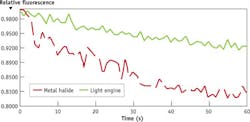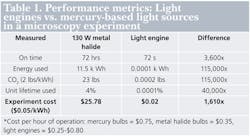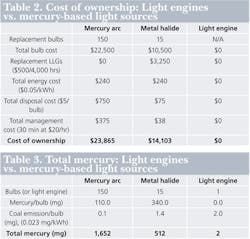The mercury arc lamp has long been the mainstay light source for fluorescence microscopy because of the bright spectral bands it generates within the visible wavelengths. Traditionally, almost every research- or clinical-grade fluorescence microscope has been equipped with a mercury arc lamp. Unfortunately, however, these sources are hazardous, unreliable, inefficient, and expensive to use.
Health concerns related to mercury-containing products are notorious. When mercury, a toxic element, escapes into the environment, it bioaccumulates in organisms and biomagnifies as it is consumed within a given food chain. Human exposure to mercury from vapor or from a diet of mercury-contaminated foodstuffs can slowly concentrate, leading to neurological pathologies.
Other health hazards associated with mercury arc lamps include high operating temperature and strong UV emission.1 Many institutions, including the National Institutes of Health (NIH), have a mercury-free policy,2 but mercury-based, science-grade lighting is exempt because it is "essential in health care facilities."3 Thanks to technology advances, though, such mercury-based lighting has become antiquated. Mercury-free lighting is available in the form of solid-state light engines with no compromise in technical performance, with respect to any figure of merit such as power, intensity, lifetime, or switching speed.
Substitute needed
Innovators have pursued a number of technologies in an effort to replace the venerable mercury arc lamp.
Metal-halide-doped mercury arc lamps became widely employed in the last decade because they address the reliability concerns around traditional mercury bulbs, increasing bulb longevity 10 times. But metal-halide bulbs also have much higher mercury concentration than traditional mercury bulbs.
Ozone-free xenon sources have no mercury and thus reduce hazardous waste, but they perform at a similarly high power consumption. Ironically, this is despite their overall lower light output intensity.
Solid-state technologies like LED illumination have the potential to solve all the concerns associated with the use of mercury, but traditional LEDs alone have yet to achieve the brightness needed for microscopy. While solid-state lasers provide the highest intensity and optical power of the lighting sources available for life science (including LEDs vs. lamps vs. lasers), they are typically cost-prohibitive for routine techniques.
Thus, the use of mercury arc lamps has remained—and despite its shortcomings, mercury has continued to be part of the equation in the form of required lighting equipment associated with research laboratories and hospital clinics for decades.
Solid-state "light engines" represent a new, clean technology that provides scientists with the opportunity to replace mercury-based lighting in the laboratory with a superior, sustainable alternative. A light engine is not simply a light source, but is a critical optical subsystem that includes all of the elements necessary to provide light to the instrument's optical train or directly to the sample. It can include multiple solid-state sources, bandpass filters, the function of a shutter, an aperture, a controller, and all the electronics to properly drive it. Moreover, it is the light engine that essentially dictates the signal/noise (S/N) of the analytical system, therefore making it among the most important hardware components in any microscopy or bioanalysis platform. Affordable, solid-state light engines can meet and exceed the spectral properties of the mercury arc lamp. In so doing, they obviate the toxicity and energy inefficiency disadvantages that have been associated with microscopy—and are in fact attributable to the limited performance of any arc lamp.
Light engines compared
Whereas metal-halide-doped lamps may contain three times the amount of mercury as do the standard mercury arc lamps,4 light engines contain no mercury and are compliant with the European Union's Restriction of Hazardous Substances (RoHS) directive.
Mercury arc lamps operate at 1400°F and are at risk of rupture—that is, discharging hot fragments of quartz, metal products, and mercury vapor. Light engines are operationally cool and remain at ambient temperatures.
Mercury bulbs are rated at the highest ANSI/IESNA Standard RP-27 Risk Group 3, meaning even momentary exposure is hazardous because of their strong ultraviolet (UV) emission. Light engines are designed specifically to output only visible light, not UV.
The high operational temperatures and UV light from mercury bulbs can combine to form ozone and nitrogen oxides, so additional resources are needed to remove the heat and toxic gas from the local environment. Light engines, by comparison, produce no such heat or phototoxins. The toxic wavelengths can also affect the photochemistry of the fluorescent dyes used during experiments. As an example, a solution of a 1mM fluorescein isothiocyanate (FITC) will bleach faster with a shuttered metal-halide source than it will when illuminated by a pulsed light engine (see figure).
Further examples demonstrate the savings in energy consumption, lifelong cost of ownership, and total mercury usage a solid-state light engine affords:
Example 1: Energy consumption and cost per experiment
Typical mercury arc lamps stabilize 30 min post-ignition and require a 30 min cool-down period before any re-ignition. For convenience, most microscope operators keep the lamps lit for the entire workday, even when no illumination is needed. This practice draws a significant amount of power unnecessarily. Data supports5 that a 130 W metal-halide lamp operates at 160 W/hr in a typical microscope core facility. By comparison, a light engine operates at an average of 5 W/hr; because light engines require no warm-up time, they consume energy only when illumination is needed.
In an experiment that requires one second of illumination every hour for three days, the arc lamp as light source must remain on for the entire 72 hours. A light engine, however, needs to stay on only 72 seconds. Because of the operational constrains of a lamp, a light engine uses 1000% less energy, and dramatically lowers the carbon footprint of the instrument it supports (see Table 1).
A typical metal-halide-doped mercury arc lamp can be employed to perform this hypothetical experiment 25 times, assuming the lamp is used only for these experiments. The standard mercury arc lamp lifetime is 10 times shorter, so this experiment would be successful only twice; the bulb would fail during the third experiment. In sharp contrast, the light engine can support this experiment one million times—and at a fraction of the cost.
The need for frequent replacement of mercury arc lamps due to the relatively short lifetimes adds to the cost of ownership and unreliability of a microscope. More important is the savings from experiments that no longer fail due to issues with arc lamp illumination. Samples can take a very long time to prepare and reagents can be quite expensive, so artifacts or failures caused by the lamp are frustrating—even intolerable. The stability and longevity of solid-state technologies employed by light engines not only eliminates failure rates during the time course of any bulb-based lighting product and eliminates the frustration caused by the distraction of short-term illumination, but also increases the quality and fidelity of data acquired on the instrument and reduces expensive downtime.
Example 2: Lifetime cost of ownership
In the above example, the arc lamp is actually not needed 99.97% of the time, but it must remain on to maintain stability. Conversely, the "instant on/off" capability of light engines (that is, the fact that no warm-up time is needed) effectively means more usable hours dedicated to experimentation for a light engine than for any lamp, effectively increasing the number of arc lamp equivalents required to achieve a similar lifetime. Conservatively assuming that half of the time a mercury arc lamp is spent on when it is not in use, then the light engine will replace an additional 50% of lamps—that is, 15 mercury-containing metal-halide lamps or 150 mercury arc lamps. Table 2 estimates the cost of ownership of a mercury arc lamp and metal-halide lamp over the lifetime of a light engine. Unlike arc lamps, the more frequently the light engine is turned off, the longer it will last—which further increases cost-of-ownership differences.
Example 3: Total mercury savings
The amount of mercury contained within these traditional lamp-based sources, plus the equivalent amount of mercury emitted by coal-power plants when operating each light source, is another consideration (see Table 3). The amount of mercury required to manufacture and operate a mercury arc lamp illuminator over the lifetime of a light engine is equivalent to 1,842 compact fluorescent light (CFL) bulbs; for metal-halide systems, it is equivalent to 579 CFL bulbs. Again, the mercury savings will increase whenever the light engine is turned off while the arc lamp must remain on to maintain stability. Clearly, the replacement of arc lamps with light engines eliminates potential mercury and health hazards. Further, instances of non-compliant storage or disposal of mercury-containing products are obviated by the elimination of such bulbs. Institutions with hundreds of microscopes that adopt light engine technology will save millions of dollars and kilograms of mercury waste.
Help to clear the initial-investment hurdle
The barrier to mercury replacement for many laboratories is the initial cost to retrofit existing equipment with light engines. Mercury Free Microscopy (MFM) is a targeted awareness campaign initiated by McGill University and Lumencor in late 2012 (see "A program to help labs "go green") designed to address this reality. It aims to help the institutional imaging core facility director, who is the ideal champion for the MFM program, by providing local expertise. The strategy empowers the MFM champion to consolidate the instrumentation network, centralize instrument administration, explore alternative funding sources, become involved in green laboratory programs, and be an increasingly recognized institutional resource for equipment grants and experimental design.
The successful MFM program will create a financial partnership using laboratories' consumables budgets, funds from institutional stake holders such as sustainability and environmental health and safety programs, the buying power of the institution, energy rebate and incentive programs, and potential monies from private donations to defray the cost of light engines. MFM will boost institutional mandates for mercury and energy reductions while improving the quality of the science and scientific data and in the process, saving millions of dollars.
References
1. See http://bit.ly/1acy3KP.
2. See http://1.usa.gov/1dfep3U.
3. See http://1.usa.gov/1ibFfHR.
4. See http://bit.ly/1dfewMP.
5. Power measurements recorded for 30 days on similar imaging workstations with similar usage time at the Nikon Imaging Facility at Harvard University, courtesy of Dr. Jennifer Waters; https://nic.med.harvard.edu.


